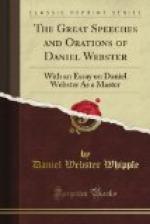[Footnote 1: Sturges v. Crowninshield, 4 Wheat. Rep. 122.]
THE MURDER OF CAPTAIN JOSEPH WHITE.
AN ARGUMENT ON THE TRIAL OF JOHN FRANCIS KNAPP, FOR THE MURDER OF JOSEPH WHITE, OF SALEM, IN ESSEX COUNTY, MASSACHUSETTS, ON THE NIGHT OF THE 6TH OF APRIL, 1830.
[The following argument was addressed to the jury at a trial for a remarkable murder. A more extraordinary case never occurred in this country, nor is it equalled in strange interest by any trial in the French Causes Celebres or the English State Trials. Deep sensation and intense curiosity were excited through the whole country, at the time of the occurrence of the event, not only by the atrocity of the crime, but by the position of the victim, and the romantic incidents in the detection and fate of the assassin and his accomplices.
The following outline of the facts will assist the reader to understand the bearings of the argument.
Joseph White, Esq. was found murdered in his bed, in his mansion-house, on the morning of the 7th of April, 1830. He was a wealthy merchant of Salem, eighty-two years of age, and had for many years given up active business. His servant-man rose that morning at six o’clock, and on going down into the kitchen, and opening the shutters of the window, saw that the back window of the east parlor was open, and that a plank was raised to the window from the back yard; he then went into the parlor, but saw no trace of any person having been there. He went to the apartment of the maid-servant, and told her, and then into Mr. White’s chamber by its back door, and saw that the door of his chamber, leading into the front entry, was open. On approaching the bed, he found the bed-clothes turned down, and Mr. White dead, his countenance pallid, and his night-clothes and bed drenched in blood. He hastened to the neighboring houses to make known the event. He and the maid-servant were the only persons who slept in the house that night, except Mr. White himself, whose niece, Mrs. Beckford, his house-keeper, was then absent on a visit to her daughter, at Wenham.
The physicians and the coroner’s jury, who were called to examine the body, found on it thirteen deep stabs, made as if by a sharp dirk or poniard, and the appearance of a heavy blow on the left temple, which had fractured the skull, but not broken the skin. The body was cold, and appeared to have been lifeless many hours.
On examining the apartments of the house, it did not appear that any valuable articles had been taken, or the house ransacked for them; there was a rouleau of doubloons in an iron chest in his chamber, and costly plate in other apartments, none of which was missing.




